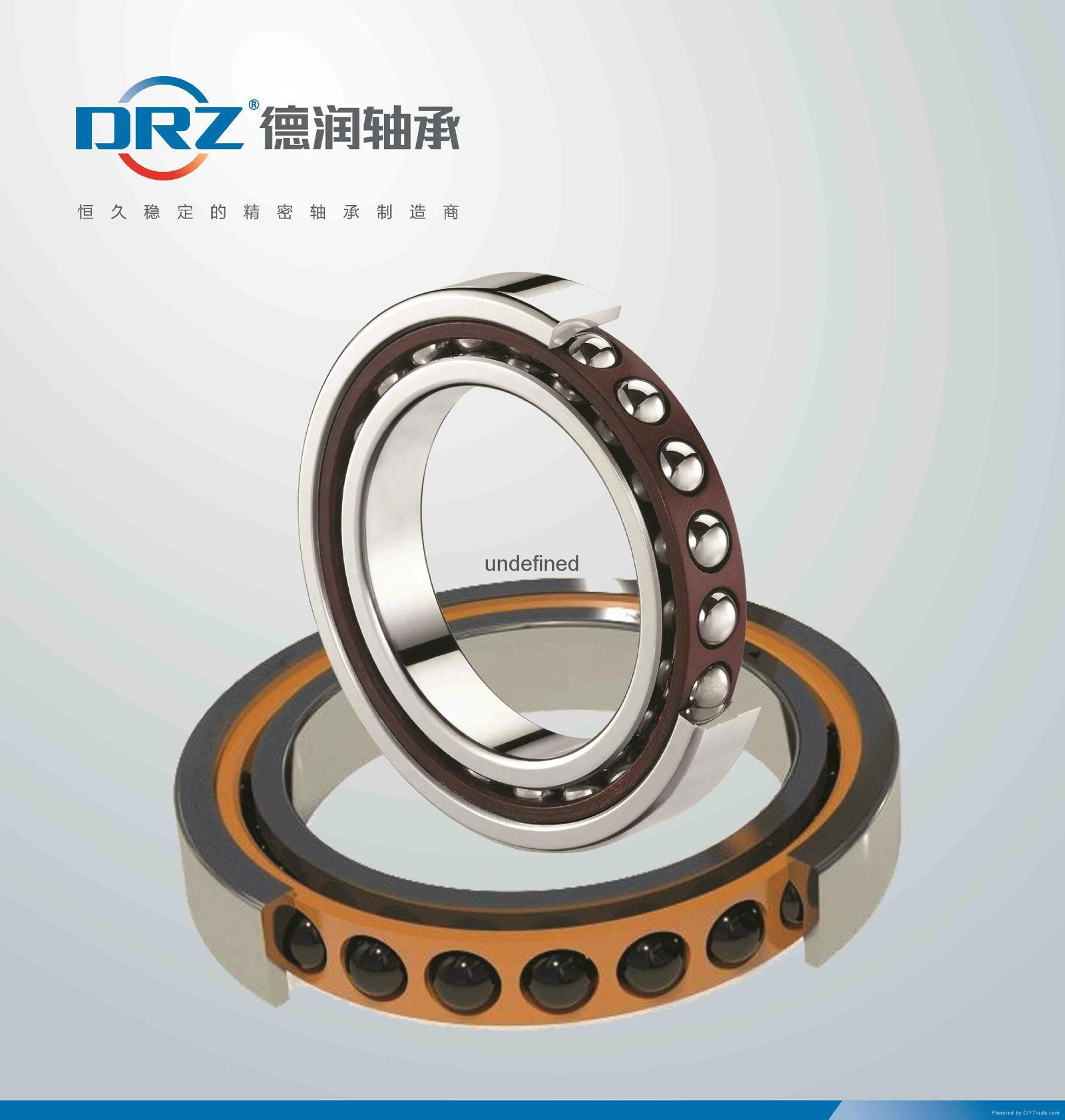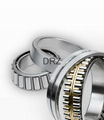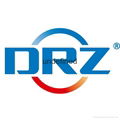| Model: | 7000 |
|---|---|
| Brand: | DRZ |
| Origin: | Made In China |
| Category: | Industrial Supplies / Machine Hardware / Insulation |
| Label: | - |
| Price: |
¥150
/ pc
|
| Min. Order: | 100 pc |
Product Description
An angular contact ball bearing uses axially asymmetric races. An axial load passes in a straight line through the bearing, whereas a radial load takes an oblique path that tends to want to separate the races axially. So the angle of contact on the inner race is the same as that on the outer race. Angular contact bearings better support "combined loads" (loading in both the radial and axial directions) and the contact angle of the bearing should be matched to the relative proportions of each. The larger the contact angle (typically in the range 10 to 45 degrees), the higher the axial load supported, but the lower the radial load. In high speed applications, such as turbines, jet engines, and dentistry equipment, the centrifugal forces generated by the balls changes the contact angle at the inner and outer race. Ceramics such as silicon nitride are now regularly used in such applications due to their low density (40% of steel). These materials significantly reduce centrifugal force and function well in high temperature environments. They also tend to wear in a similar way to bearing steel—rather than cracking or shattering like glass or porcelain.

Angular contact ball bearing have high limit rotational speed, they can carry radial load and axialload simultaneously, they cal also withstand purely radial load. The axial load carrying capacity dependson the magnitude of contact angle and increases with increasing contact angle.
Structures

1. Separable angular contact ball bearings
The inner ring and outer ring of this type of bearings cannot be separated and comprises following structures:
Contact angle *=15°, counter bore on outer ring, 7000C type
Contact angle *=25°, counter bore on outer ring, 7000ACtype
Contact angle *=40°, counter bore on outer ring, 7000B type
2. Four-point contact ball bearings
This type of bearings is separable bearings. Whereof, QJ000 type has two piece inner ring and QJF000 type has two piece outer ring. Their contact angles are same as 35°. When received no load or pure radial load, the steel balls of the ball bearing contact with the four points of the rings. Besides the steel balls perform a two point contact with the ring when it is received a pure axial load. In addition, besides the axial load from both directions, this kind of bearing can take torque-load as well.
3. Double row angular contact ball bearings
This kind of bearings can accommodate radial loads as well as axial loads acting in both directions; they can also take torque load. They can restrain the axial displacement from both directions of the shaft or housing; the contact angle is 30° (or 40°).
Cage material
Angular contact ball bearings generally adopt pressed steel cages or copper solid cages. Double-row angular contact ball bearings generally adopt copper solid cages.
Sealing solutions
Bearings sealed on both sides are lubricated for the life of the bearing and should not be washed or relubricated. The bearings are considered virtually maintenance free. If they are to be hot mounted, an induction heater should be used. we do not recommend heating capped bearings above 80 °C (175 °F). However, if higher temperatures are necessary make sure that the temperature does not exceed the permissible temperature of either the seal or grease, whichever is lowest. During start up, grease may leak at the inner ring. For bearing arrangements where this would be detrimental, special design steps must be undertaken.
Non-contact seals
Bearings with non contact seals can be operated at the same speeds as open bearings. The seals form an extremely narrow gap with the inner ring shoulder (fig. 1). They are made of oil and wear resistant NBR that is reinforced by a sheet steel insert. The seals, which are fitted in a recess on the outer ring, make good, positive contact with the recess.
Single row angular contact ball bearings with a non contact seal on both sides are identified by the designation suffix 2RZ.
Greases for sealed bearings
Sealed single row angular contact ball bearings are filled as standard with the high performance polyurea grease (GXN). Its specifications are listed in table 1. The standard grease is not identified in the bearing designation (no designation suffix).
Permissible speed
The permissible speed can be estimated using the speed ratings listed in the product table and applying the information provided under Speeds. If no reference speed is listed in the product table, the limiting speed is the permissible speed.
Bearing pairs
For bearings arranged in pairs, the permissible speed calculated for a single bearing should be reduced to approximately 80% of the quoted value.

Design of bearing arrangements
Proper adjustment
Single row angular contact ball bearings must either be used with a second bearing (fig. 1) or in sets . The bearings must be adjusted against each other until the requisite clearance or preload is obtained (→ Bearing preload).
When universally matchable bearings are mounted immediately adjacent to each other, there is no need for adjustment (→ Bearings for universal matching). The requisite clearance or preload is obtained by choosing bearings from an appropriate clearance or preload class and by applying suitable fits for the bearings on the shaft and in the housing.
The performance and operational reliability of single bearings depend on proper adjustment while universally matchable bearings depend on the correct selection of clearance or preload. If there is too much clearance in the bearing arrangement during operation, the load carrying capacity of the bearings is not fully utilized. Excessive preload produces more friction and higher operating temperatures, leading to a reduction in bearing service life.
Axial loads in one direction
Back to back and face to face arrangements require special attention when the axial load acts predominantly in one direction. This creates unfavourable rolling conditions for the balls of the axially unloaded bearing and can lead to increased noise levels, discontinuity in the lubricant film and increased stresses on the cage. When the axial load acts predominantly in one direction, we recommends zero operating clearance, which can be attained by using springs.
Load ratio
Because of the 40° contact angle, favourable rolling conditions for bearings in the 70 B, 72 B(E) and 73 B(E) series require a load ratio of Fa/Fr ≥ 1. A load ratio of Fa/Fr < 1 can reduce bearing service life.
Features
1.High Quality Steel - Ultra clean steel to extend bearing life by up to 80%.
2.Advanced Grease Technology - lubricants that can extend grease life and performance.
3.High Grade Balls - Quiet and smooth operation even at high speed.
4.Super Finished Raceways - Specially honed to minimise noise and improve lubricant distribution and life.
5.Contact Angle - Offered in 15, 25, 30 and 40 degree angles.
6.Cages - Available in a range of Polyamide, steel and brass cage assemblies.
Angular Contact Ball Bearing Series
Many angular contact bearing manufacturers have three or more dimensional series to accommodate higher speeds or higher loads than “standard.” In particular, the most common series names are:
ISO 18 Series - highest speed, lowest load bearings
ISO 19 Series - second highest speed, with the second lowest load bearings
ISO 10 Series - highest load, second lowest speed bearings
ISO 02 Series - highest load, lowest speed bearings
ISO Equivalents to DRZ's Series Designations
Many times, manufacturers have further separated the ISO dimensional classes by adding a higher speed variant with the same dimensions. The following table summarizes DRZ's product offerings:
ISO Series DRZ Designation
ISO 18 718 Series Angular Contact Bearings
ISO 19 719 Series Angular Contact Bearings
ISO 19 (high speed)H719 Series Angular Contact Bearings
ISO 10 70 Series Angular Contact Bearings
ISO 10 (high speed)H70 Series Angular Contact Bearings
ISO 10 (high load)B70 Series Angular Contact Bearings
ISO 02 72 Series Angular Contact Bearings
Permissible tilt angle
There is only a little inclination between the inner ring and outer ring of angular contact bearings, the permissible tilt angle varies according to the internal clearance when the bearings are operating, the bearing dimensions, internal design and the force and torque load received by the bearings. The value of the maximum permissible tilt angle should be able to ensure that no much extra stress to be generated inside the bearings. The tilt angle existing between the inner ring and outer ring will influence the bearing service life. Meanwhile, the running accuracy is decreased down and noise increased.
Bearings for universal matching
Bearings for universal matching are intended to be used in sets. The width and the standout of the rings are manufactured to close tolerances. When two bearings are mounted immediately adjacent to each other, a given internal clearance or preload or an even load distribution between the two bearings is obtained without the use of shims or similar devices.
Bearings for universal matching can also be beneficial in arrangements with single bearings. Most bearings belong to the DRZ performance class and as such have higher precision, increased load carrying capacity and speed capability.
Bearings for universal matching are identified by the following suffixes:
CA, CB, CC or G for internal clearance
GA, GB or GC for preload
Paired mounting
Paired mounting can be done in three ways:
Tandem arrangement
A tandem arrangement is used when the load carrying capacity of a single bearing is inadequate. When arranged in tandem, the load lines are parallel and the radial and axial loads are equally shared by the bearings. However, the bearing set can accommodate axial loads in one direction only. If axial loads act in both directions, a third bearing, adjusted against the tandem pair, must be added.
Back-to-back arrangement
Mounting two bearings back to back provides a relatively stiff bearing arrangement, which can also accommodate tilting moments. When arranged back to back, the load lines diverge towards the bearing axis. Axial loads in both directions can be accommodated, but only by one bearing in each direction.
Face-to-face arrangement
Mounting two bearings face to face is not as stiff as a back to back arrangement, but less sensitive to misalignment. When arranged face to face, the load lines converge towards the bearing axis. Axial loads in both directions can be accommodated, but only by one bearing in each direction.
.jpg)
Dynamic equivalent radial load
1) Single bearing or tandem arrangement of single row angular contact ball bearings with a contact angle of 15°.
2) Single bearing or in tandem arrangement*7000C*7000C/DT*
Pr=Fr When Fa/Fr * e
Pr=0.44Fr+YFa When Fa/Fr *e
Back-to-back and face-to-face arrangements*7000C/DB*7000C/DF*
Pr=Fr +Y1Fa When Fa/Fr *e
Pr=0.72Fr+Y2Fa When Fa/Fr *e
Single row angular contact ball bearings with a contact angle of 25°. Single bearing or tandem arrangement*7000AC*7000AC/DT*
Pr=Fr When Fa/Fr*0.68 Pr=0.41Fr+0.87Fa
When Fa/Fr*0.68
Back to back and face to face arrangements*7000AC/DB*7000AC/DF*
Pr=Fr+0.92Fa
When Fa/Fr*0.68
Pr=0.67Fr+1.41Fa
When Fa/Fr*0.68
3) Single row angular contact ball bearings with a contact angle of 40°.
Single bearing or tandem arrangement*7000B*7000B/DT*
Pr=Fr When Fa/Fr*1.14 Pr=0.35Fr+0.57Fa
When Fa/Fr*1.14 Back to back and face to face arrangements*7000B/DB*7000B/DF*
Pr=Fr+0.55Fa
When Fa/Fr*1.14 Pr=0.57Fr+0.93Fa
When Fa/Fr*1.14
4) Four point contact ball bearings with a contact angle of 35°
Pr=Fr+0.66Fa When Fa/Fr*0.95 Pr=0.6Fr+1.07Fa
When Fa/Fr*0.95
5) Double row angular contact ball bearings with a contact angle of 45°.
Pr=Fr+0.47Fa When Fa/Fr*1.34 Pr=0.54Fr+0.81Fa
When Fa/Fr*1.34
In the formula: Pr Dynamic equivalent radial load (N) Fr Actual radial load of the bearing (N)
Annexed Table 2 Computing coefficient e, Y, Y1 andY2
|
Fa/Cor |
Fa (ZDW2 ) |
e |
Y |
Y1 |
Y2 |
|
0.015 |
0.172 |
0.38 |
1.47 |
1.65 |
2.39 |
|
0.029 |
0.345 |
0.4 |
1.4 |
1.57 |
2.28 |
|
0.058 |
0.689 |
0.43 |
1.3 |
1.46 |
2.11 |
|
0.087 |
1.03 |
0.46 |
1.23 |
1.38 |
2 |
|
0.12 |
1.38 |
0.47 |
1.19 |
1.34 |
1.93 |
|
0.17 |
2.07 |
0.5 |
1.12 |
1.26 |
1.82 |
|
0.29 |
3.45 |
0.55 |
1.02 |
1.14 |
1.66 |
|
0.44 |
5.17 |
0.56 |
1 |
1.12 |
1.63 |
|
0.58 |
6.89 |
0.56 |
1 |
1.12 |
1.63
|
Static equivalent radial load
1) Single bearing or tandem arrangement of single row angular contact ball bearings with a contact angle of 15°.*7000C*7000C/DT* Por=0.5Fr+0.46Fa
Por=Fr When Por*Fr Back to back and face to face arrangements*7000C/DB*7000C/DF* Por=Fr+0.92Fa
2) Single row angular contact ball bearings with a contact angle of 25°.
Single bearing or tandem arrangement*7000AC*7000AC/DT*
Por=0.5Fr+0.38Fa
Por=Fr When Por*Fr
Back-to-back and face-toface arrangements*7000AC/DB*7000AC/DF*
Por=Fr+0.76Fa
3) Single-row angular contact ball bearings with a contact angle of 40°.
Single bearing or tandem arrangement*7000B*7000B/DT*
Por=0.5Fr+0.26Fa Por=Fr When Por*Fr
Back-to-back and face-to-face arrangements*7000B/DB*7000B/DF* Por=Fr+0.52Fa
4) Four point contact ball bearings with a contact angle of 35° Por=Fr+0.58Fa
5) Double-row angular contact ball bearings with a contact angle of 45°.
Por=Fr+0.44Fa
In the formula:
Por Dynamic equivalent radial load (N)
Fr Actual radial load of the bearing (N)
A damaging sliding will be generated between the balls and the raceway by inertia force when preventing the bearings from high speed rotating, so the bearing must carry certain load. The minimum load can be estimated with the equation below:
1. Single-row angular contact ball bearings
1) The minimum axial preload of a single bearing or a tandem arrangement Famin=Ka(Cor/1000)(ndm/100000) 2 2)The minimum axial preload of back-back or face-to-face arrangement Frmin=Kr(vn/1000) 2/3(dm/100) 2
In the formula: Famin The minimum axial preload (N) Frmin The minimum radial preload (N)
Cor Basic static load rating (N) n Bearing rotation speed (r/min) dm Bearing mean diameter
dm = (d+D)/2 (mm)
V Lubricating oil viscosity under operating temperature *mm /s2*
Ka Minimum axial load factor Ka=1.4 72series Ka=1.6 73series
Kr Minimum radial load factor Kr=95 72series Kr=100 73series
2. Double-row angular contact ball bearings Minimum radial preload
Frmin=Kr(Vn/1000)2/3(dm/100) 2
In the equation:
Frmin Minimum radial preload (N)
n Bearing rotation speed (r/min)
dm Bearing mean diameter m=(d+D)/2 (mm)
V Lubricating oil viscosity under operating temperature 2(mm /s)
Kr Minimum radial load factor
Kr=80 32series
Kr=60 32Aseries
Kr=95 33series
3. Four point angular contact ball bearings
Minimum axial preload Famin=Ka(Cor/1000)(ndm/100000) 2
In the equation:
Famin Minimum axial preload (N) Cor Basic static axial load rating (N) n Bearing rotation speed (r/min)
dm Bearing mean diameter m =(d+D)/2 (mm)
Ka Minimum axial load factor
Ka=1.0 QJ2series
Ka=1.1 QJ3series
When the actual load acted on the bearing is less than the minimum load computed, a spring and other measures must be used to preload the bearing.
Operating temperature-20*+120* When the operating temperature exceeds +120*, please contact with Technical Department.
Safety coefficient
The allowable equivalent static load of a bearing depends on the basic static load rating of the bearing. While permanent deformation quantity said above (local depressed quantity) decides bearing performance and service conditions.
So, safety coefficient is made out for analyzing the safety degree of the basic static load rating. So=Cor/Pormax.
In the equation: Pormax The maximum static equivalent load allowed to be acted on the bearing (N) Cor Basic static load rating (N).
Basic rating life
The simplest method to calculate the life of cylindrical roller bearings is to use ISO Basic rating life formula: L10=(Cr/Pr)3
In the formula:
L10 Basic rating life (10 revolutions)
Cr Basic dynamic radial load rating (N)
Pr Dynamic equivalent radial load (N)
1. The largest single round angle radius of the shaft and bore, rasmax is seen in Annexed Table 3
2. The minimum height of abutment hmin is seen in Annexed Table 3.
3. Calculation of mounting dimensions.
The height of shaft or the abutment of the bore is larger than the largest permissible size of bearing chamfer, and the shasft or bore abutment contacts the plain part of bearing end face; the corner radium of the shaft and the bore, rasmin, is smaller than the smallest permissible size of bearing chamfer, so not to affect mounting. Generally the values of abutments and corner radium in Appendix 3 are adopted. In order to reduce stress concentration and increase shaft intensity, when it is required that the corner radium of the abutment size of the shaft and bore is larger than the size of bearing chamfer which results in insufficient contact area, then a spacer can be put between the abutment of the shaft or bore with the bearing. The mounting dimensions of rolling bearings are the connecting sizes in connection with the internal design of the bearings. For angular contact ball beatings, the mounting dimensions are mainly depend on the actual end face width of inner ring and outer rings. The minimum value of abutment hmin is given in the standard; the main unit designers can follow the formula below to calculate mounting dimensions:
dbmin=d+2h min Db max=D-2hmin
In the formula: dbmin Minimum diameter of shaft abutment (mm) Dbmax Maximum diameter of seat bore abutment (mm)
In order to get the optimum design for the bearing parts, the main designer should contact with Technical Department.
Customer services
.jpg)
According to customers needs to design all kinds of standard and nonstandard angular contact ball bearings, please contact with Technical Department for related information.
|
L10 |
Basic rating life |
(10 revolutions) |
|
|
|
Cr |
Basic dynamic radial load rating |
(N) |
|
|
Pr |
Dynamic equivalent radial load |
(N) |
|
|
|
|
|
The height of shaft or the abutment of the bore is larger than the largest permissible size of bearing chamfer, and the shasft or bore abutment contacts the plain part of bearing end face; the corner radium of the shaft and the bore, rasmin, is smaller than the smallest permissible size of bearing chamfer, so not to affect mounting. Generally the values of abutments and corner radium in Appendix 3 are adopted. In order to reduce stress concentration and increase shaft intensity, when it is required that the corner radium of the abutment size of the shaft and bore is larger than the size of bearing chamfer which results in insufficient contact area, then a spacer can be put between the abutment of the shaft or bore with the bearing. The mounting dimensions of rolling bearings are the connecting sizes in connection with the internal design of the bearings. For angular contact ball beatings, the mounting dimensions are mainly depend on the actual end face width of inner ring and outer rings. The minimum value of abutment hmin is given in the standard; the main unit designers can follow the formula below to calculate mounting dimensions:
dbmin=d+2hmin Dbmax=D-2hmin
In the formula: dbmin Minimum diameter of shaft abutment (mm) Dbmax Maximum diameter of seat bore abutment (mm)
In order to get the optimum design for the bearing parts, the main designer should contact with Technical Department.
According to customers needs to design all kinds of standard and nonstandard angular contact ball bearings, please contact with Technical Department for related information.
Table l Operational safety coefficient :
|
Operating condition |
|
|
|
Regular rotation |
Require high rotational accuracy General applications General operating conditions with vibration and impact load |
2 1 1.5 |
|
Unfrequent rotation (Sometime swing) |
General applications Applications with impact load or unevernly distributed load |
0.5 1 |
Applications
Machine tool spindles
grinding wheel spindles
liquid power transmission cases on internal combustion engines worn reducers,
electric drills
centrifugal machines
superchargers and others
Agriculture
Chemical
General industry
Utilities
Member Information
| Luoyang Derun Precision Machine Tool Bearings co.,ltd. | |
|---|---|
| Country/Region: | He Nan - China |
| Business Nature: | Manufacturer |
| Phone: | 13903792631 |
| Contact: | yancheng wang (sales) |
| Last Online: | 31 May, 2018 |
Related Products of this Company






